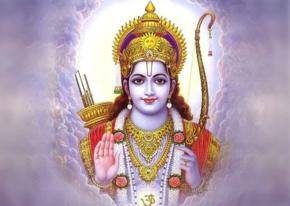Why are we still talking about Ram Rajya?

Last week we had the Sri Ram Navmi celebrations. Though Lord Ram lived and ruled India some 10,000 years ago, his life and values are still extolled. There is hardly any King in the Indian history who is celebrated till today, except King Ram of Ayodhya.
Lord Ram’s legacy still rules the hearts of Indian people including our politicians. Just last month India’s opposition party BJP’s president Nitin Gadkari chanted a new mantra for Ram Rajya to his party workers to bring back the glory of Ram Rajya back in the 21st century. Last year the BJP unveiled their election manifesto pledging to work for the purpose of bringing in 'Ram Rajya' in the country on the occasion of Ram Navmi. To cap it all the Gujarat Chief Minister Narendra Modi said he believes in Gandhi’s Ram Rajya. When pressed, Modi explained that Ram Rajya meant a “welfare state”.
Even the late Rajiv Gandhi (former Prime Minister of India) inaugurated the Congress party’s 1989 election campaign from the vicinity of Ayodhya with a promise to usher in Ram Rajya, which was also Mahatma Gandhi’s dream. There have been and still are many politicians who wish to give Ram Rajya a concrete shape in their own way.
But was there any period in Indian history where we had a glimpse of a golden period or an ideal society? In fact the 17th century saint Sant Tukaram extolled Chhatrapati Shivaji Maharaj's reign as Ram Rajya in which ruler and subjects were all equal and there was all-round welfare.
However it’s to be noted that the legend of Ram whose exemplary character and governance more than 10,000 years ago, makes it the most popular text book on moral living and righteous polity.
In post-colonial India, Ram Rajya as a concept was first projected by Mahatma Gandhi. Gandhiji announced that Ram Rajya would be brought once Independence arrived. When he was asked about the ideal State, he talked about Ram Rajya. By using the Ram Rajya slogan, Gandhiji implied an ideal Rajya (without being communal) where values of justice, equality, idealism, renunciation and sacrifice are practised.
To quote Mahatma Gandhi on Ram Rajya, he said and wrote on February 26, 1947, "Let no one commit the mistake of thinking that Ramrajya means a rule of Hindus. My Ram is another name for Khuda or God. I want Khuda Raj which is the same thing as the Kingdom of God on Earth." Obviously this meant an ideal society where everybody follows a code of righteous living and more or less happy, meeting all their essential needs.
Ram Rajya according to many scholars meant that the state (Rajya) was the sole legitimate agency wielding power (force), which imposes limits upon its exercise of power, either for the greater happiness of the people, or to evade a greater tyranny that could be caused by moral outrage or self-righteousness.
Historically, from the Ramayana, the chapter on Ayodhya gives a majestic description of Ram Rajya, where peace, prosperity and tranquility reigned, for there was no one to challenge the seat of Ayodhya, literally the land without wars. Incidentally in Hindi, "Ayodhya" means "a place where there is no war." Hence "Ram Rajya" is described as an ideal society. Is there any country that doesn’t want peace, prosperity and tranquility?
According to many authors who have researched the Indian epic (Itihaas) Ramayana have concluded that Ram Rajya is not a myth or imagination, it is an historic truth of it times and for the time to come. It is not a proletysing concept and not a dystopian relic.
So why are still talking about Ram Rajya in this day and age…well I guess everybody, anywhere in the world wants good governance and with the heritage of Lord Ram that we have, the name of Lord Ram becomes a rubber stamp for anything associated with the good. Just recently the India's Law and Justice Minister Dr. M Veerappa Moily who is also an eminent poet, writer, and thinker was awarded the Bharatiya Jnanpith's prestigious 21st Moortidevi Award for his outstanding five-volume magnum opus ‘Shri Ramayana Mahanveshanam’. According to Mr.Moily, what present day India has to learn from the Ramayana is to build a nation out of many voices, many cultures and many peoples.
To quote Mr. Moily from his acceptance speech that ''At the heart of the epic there are three distinct cultures: the Lankan culture of acquisition, pleasure and power; the Ayodhya culture of artistic and academic progress and the culture of Kiskindha... mostly tribal and backward in terms of development in the modern sense. Initially, there is friction among these three cultures. However, when Vibhishana, the Rakshasa King, and Hanuman, the Vaanara noble, become allies of Rama, the King of Ayodhya, all the three cultures come together and fuse into one great culture-- the culture of Rama Rajya.''
Dr Moily recited a stanza describing King Dashrath's attitude in treating even the poorest of the poor as ''equal,'' saying ''his feelings reflect true Rama Rajya.'' Another stanza he cited dwelt on the education Vishwamitra imparted to Rama and Lakshamana, by ordering the brothers to walk instead of covering a distance on chariot. ''Unless the rulers, administrators, experience the pain and suffering of the poorest and weakest, they cannot be good in their jobs,'' he summed up.
May be this knowledge of the heritage of Ram Rajya is the starting of something that is going to shine India in modern times.




